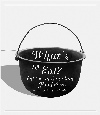
What’s To Eat? Entrees In Canadian Food History
Edited By Nathalie Cooke
McGill-Queen's University Press
$29.95
paper
320pp
978-0-7735-3571-8
What’s to Eat? is an academic book with crossover appeal for readers from the “granola-meets-gourmet” foodie subculture (to borrow a term from contributor Sarah Musgrave, a Montreal journalist). Anyone who roasts their own coffee beans or smokes their own bacon, or who simply makes a point of buying raw milk cheese, artisanal bread, or fair-trade chocolate will find practical inspiration – aboriginal recipes for heirloom vegetables, ideas for a traditional Thanksgiving menu – in this otherwise theoretical book.
In her chapter “A Cargo of Cocoa: Chocolate’s Early History in Canada,” Catherine MacPherson, a CBC radio food columnist and researcher at the McCord Museum, reveals that some of today’s hottest trends in chocolate, including the pairing of it with “chili, lavender, pepper, cinnamon, and other exotics,” hearken back hundreds of years. At the Fortress of Louisbourg in Cape Breton, there are records from the eighteenth century showing that officers flavoured their chocolate with “anise, orange flower water, or ambergris.” With the exception of ambergris, which is a waxlike secretion of the whale’s intestine, an ingredient not currently enjoying a revival – perhaps because of the difficulties involved in obtaining a reliable quantity – these flavours would not be out of place at a Plateau chocolatier.
MacPherson quotes from the journals of French explorer Samuel de Champlain, whose detailed observations of sixteenth- and seventeenth-century New World food practices are as fascinating today as they must have been when they were first published. In “Curiosity into Edibility: The Taste of New France,” contributor Victoria Dickenson also refers to Champlain’s journals and his instructions on how to serve pattypan squash, “little squashes as big as your fist, which we ate as a salad like cucumbers, and they were very good.” This will be of particular interest to anyone dealing with a surplus of vegetables from their garden or organic food basket. One wonders if this historical account of squash being consumed raw could have the power to spark a mini food revolution. Could squash salad one day become as essential to the gourmet palate as orange-flower chocolate?
The “everything old is new again” theme is revisited in “Talking Turkey: Thanksgiving in Canada and the United States,” a fun, informative piece from food editor Andrew Smith and McGill lecturer Shelley Boyd. Especially enjoyable are the references to Canada’s long, long history of turkey journalism: from the nineteenth-century article linking Canadian Thanksgiving to a British harvest festival, to the 1951 Macleans magazine piece, “How to Tackle that Turkey.” The suggestion is that we’ve always been a little unsure about what to eat for this holiday and why.
Editor Nathalie Cooke also explores the power of traditions in her chapter debunking the myth of the family dinner. Her witty, reassuring, critical assessment of the enduring belief in a long-gone golden age of family life would equally be at home in The Walrus or Chatelaine, and should be required reading for harried modern parents.
In her introduction, Cooke advances the proposition that cookbooks are making their way from kitchen counters to bedside tables. If she is right, and cookbooks are becoming sources of entertainment rather than information, then one can easily envision What’s to Eat? travelling from the ivory tower to private homes, especially those where a reverence for food and authenticity happily, creatively, co-habit. mRb






0 Comments